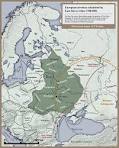 An international team of scientists has published a comprehensive genetic and linguistic research work of Slavs and Balts, showing why the Eastern and Western Slavs like each other, and the South are very different, according to the report of the Institute of General Genetics, Russian Academy of Sciences. An international team of scientists has published a comprehensive genetic and linguistic research work of Slavs and Balts, showing why the Eastern and Western Slavs like each other, and the South are very different, according to the report of the Institute of General Genetics, Russian Academy of Sciences.
research languages and Genetics of the Slavs was conducted by a team of scientists under the leadership of doctor of biological Sciences Balanovsky O. P. (Institute of General Genetics and genetic research center) and academician of Richard Willems (Estonian Biocenter and University of Tartu) and published in the journal PLoS One, reports the news Agency. The work involved Scientists From many countries, where the overwhelming number of people are Slavic and Baltic peoples (Russia, Ukraine, Belarus, Lithuania, Estonia, Croatia, Bosnia and Herzegovina), as well as Scientists from the UK and the international cartel of the Genographic project.
by definition, the Slavs are the peoples who speak Slavic languages. The similarity of all Slavic languages does not require proof. At the same time, for example, the South Slavs are outwardly very similar on the East and West. Genetics researched more than 8 thousand DNA samples From more than fifty Balto-Slavic populations. The main groups of Eastern Slavs (Belarusians, Russians, Ukrainians), West Slavic (kashubians, poles, Slovaks, Sorbs, Czechs, and South Slavs (Bulgarians, Bosnians, Macedonians, Serbs, Slovenes, Croats) and Baltic peoples (Latvians, Lithuanians). The analysis was performed for three genetic systems: is the Y chromosome, transmitted paternal mitochondrial DNA (mtDNA) is transmitted through the maternal line, and autosomal DNA, containing the genomes of father and mother (genome-wide Analysis). In all three systems was very similar picture. Eastern Slavs - Russians in Central and southern regions, as well as Belarusians and Ukrainians form a well-formed group. The exceptions are Northern Russians are genetically distant from other Eastern Slavs and gravitate to the Finno-Ugric populations. From Western Slavs, the poles are very close to the Eastern Slavs and the Czechs and to a lesser extent the Slovaks shifted to the Germans and other Western European populations. South divided into Western Slavs (Slovenes, Croats and Bosniaks) and Eastern (Macedonians and Bulgarians), the regions with the Serbs in the middle. They are genetically similar to their non-Slavic neighbours in the Balkans, Romanians, Hungarians, Greeks. Baltic population - Latvians and Lithuanians - detect the proximity to the Estonian language speakers of the Finno-Ugric group, and to a small Eastern Slavs (Belarusians). It was also found that the Baltic population is genetically close to Volga group of Finno-Ugric peoples (especially the Mordva). Turning to linguistics, Scientists built reconstructed wood Balto-Slavic languages, and for all populations compared 3 parameter - genetics, language, and geography. The highest correlation was between genetics and geographical location of populations. Scientists believe that, spreading through Europe, the Slavs were intensively engaged in their own local populations who lived on the territories in pre-Slavic times. The Slavs brought with them the language and absorb the gene pool of local populations. This deep genetic "substrate" was different for the different branches of the Slavs. Eastern European substrate adopted in Western and Eastern Slavs. Perhaps most of it amounted to the Baltic peoples, settled once very widely through the East European plain. Other, South European substrate, absorbed by Southern Slavs, and it was pre-Slavic Balkan peoples. These processes are cemented Western and Eastern Slavs into a single genetic unity, and the Southern Slavs since acquired more Affinity with non-Slavic peoples of the Balkans than with other Slavic peoples.
sections: Politics
|